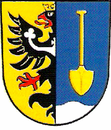Písek u Jablunkova
| Písek | ||||
|---|---|---|---|---|
|
||||
| Basic data | ||||
| State : |
|
|||
| Region : | Moravskoslezský kraj | |||
| District : | Frýdek-Místek | |||
| Area : | 1545 ha | |||
| Geographic location : | 49 ° 34 ' N , 18 ° 48' E | |||
| Height: | 420 m nm | |||
| Residents : | 1,857 (Jan 1, 2019) | |||
| Postal code : | 739 84 | |||
| License plate : | T | |||
| traffic | ||||
| Street: | Jablunkov - Żywiec | |||
| structure | ||||
| Status: | local community | |||
| Districts: | 1 | |||
| administration | ||||
| Mayor : | Věra Szkanderová (status: 2014) | |||
| Address: | Písek 51 739 84 Písek u Jablunkova |
|||
| Municipality number: | 512028 | |||
| Website : | www.pisek-obec.cz | |||
Písek (Polish Piosek , German Pisek , Piesek , Piosek ) is a municipality in the Czech Republic . It is located four kilometers southeast of Jablunkov and belongs to the Okres Frýdek-Místek .
geography
Písek is located on the right bank of the Olsa between the mountains of the Silesian Beskids and the Jablunkauer Uplands near the Polish border. The Gírová (839 m) rises to the south, the Kiczory (989 m) and the Ostrá hora (721 m) to the north.
Neighboring towns are Bystrý in the north, Jasnowice and Istebna in the east, Bukovec in the south-east, Mosty u Jablunkova in the south-west, Městská Lomná and Bocanovice in the west and Jablunkov , Folvark and Žihla in the north-west.
history
The first written mention of the village took place in 1466 in a deed on the sale of the inheritance jurisdiction , which in 1571 by the Teschener Duke Wenzel III. Adam was confirmed. In 1577 the Vogt and ten farmers lived in the village . In 1621 the regional court determined the boundaries of the village. In 1692 eight more cottagers were added and Piosek owned a mill and a farm . The size of the place did not change until the middle of the 18th century, the same number of farms is reported for 1755, but there was no more Vogt in Piosek. In 1800 the village consisted of 45 houses and had 411 inhabitants.
After the abolition of patrimonial Piosek formed a community in the Teschen district from 1850. In 1874 a Polish school was opened. At the end of the 19th century the population increased rapidly. In 1880 884 people lived in the village, ten years later there were 989. This trend continued and in 1930 Piosek had 1204 inhabitants, including 745 Catholics and 456 Protestants. The place name Pisek was used from the beginning of the 20th century. After the end of the First World War, the place belonged to Czechoslovakia. Because of the large Polish population, Poland also claimed the Olsa area and the Polish-Czechoslovak border war broke out . From 1920 the municipality was part of the Český Těšín District. After the Munich Agreement , Piosek was annexed to Poland in 1938 and joined the German Reich a year after the occupation of Poland. Until 1945 Piosek belonged to the Teschen district and returned to Czechoslovakia after the war.
At the 1950 census there were 1,308 people in Písek, 58% of them Czechs and 41% Poles. After the dissolution of the Okres Český Těšín, Písek came to the Okres Frýdek-Místek at the beginning of 1961. 1980 Písek was incorporated into Jablunkov and formed the district Jablunkov 4-Písek. During drilling in the late 1980s, a thermal spring with a high salt content was discovered near Písek. In 1990 Písek regained his independence. Since 1997 the Polish minority school has been subordinate to the Polish school in Bukovec.
Community structure
No districts have been identified for the municipality of Písek. The Folvark settlement belongs to Písek.
Attractions
- Mount Gírová
- Catholic branch church of Divine Mercy, consecrated in 1995
- Church of the Silesian Evangelical Church , consecrated in 2010
- Plenisko nature reserve on the summit of Kiczory in the Silesian Beskids , the protected area, which has existed since 1922, has had the status of a nature reserve since 1956. In 1998 it was expanded from 16.25 to 24.32 hectares.
Web links
Individual evidence
- ↑ Český statistický úřad - The population of the Czech municipalities as of January 1, 2019 (PDF; 7.4 MiB)
- ↑ Hošák, Ladislav - Šrámek, Rudolf: Místní jména na Moravě a ve Slezsku I-II. Prague


